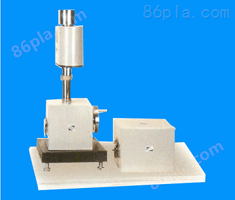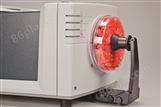XWJ—600B玻璃化溫度測定儀


本設備是由系統機控制,使試樣在爐體內以一定的加熱(制冷)速率加熱(制冷)試樣,使試樣在恒定的較小的負荷下隨溫度升高(降低)發生形變,測量試樣溫度—形變曲線并通過分析該試樣的溫度—形變曲線,研究高分子材料力學性能的儀器。它能夠測定材料在等速升溫條件下的溫度、變形曲線,從而確定材料的玻璃化溫度Tg和流動溫度Tf。它能測量各種材料的熱膨脹系數,從而確定這些材料的變化點,燒結過程、收縮率、熱膨脹等特性。可廣泛應用于高分子及其合成材料、藥物、陶瓷等材料的科研和生產中。
該儀器符合國家標準GB11998—XXXX
- 工作原理
聚合物試樣隨溫度上升,從玻璃態轉變為高彈態,從高彈態轉變為流動態。試樣的高彈態和流動態是可以通過形變過程而確定的。所以該機的工作原理就是通過鉑電阻Pt100感溫元件測量爐內的溫度,由PLC進行PID運算,控制加熱部件或制冷單元,達到等速升溫的目的。形變由數顯百分表顯示并輸出位移信號上傳至PC機,PC機繪制溫度-變形曲線。zui后通過在溫度-變形曲線上找到拐點得到Tg和Tf值。
對應于拉伸、針入等不同的實驗形式,將高分子材料制成標準尺寸的試樣,放入對應的試樣安裝架中,一同裝入控溫爐。通過電加熱器或液氮流、高精度控溫傳感器、計算機系統組成控溫系統,控制保溫爐的溫度及升、降溫速率,并實時監測試樣的溫度。通過加載桿、砝碼對試樣施加恒定的試驗力。通過數顯千分表實時測定試樣的形變量。具有一機多用,靈活方便的特點。
- 技術指標
3.1 實驗艙溫度
3.1.1 實驗艙溫度范圍:-196℃~500℃
3.1.2 實驗艙溫度控制范圍:-70℃~500℃(帶制冷)
3.1.3 溫度準確度:±0.5℃
3.1.4 升溫速率:0.5℃/ min~5℃/ min
降溫速率:-0.5℃/ min~-2℃/ min。(帶制冷)
3.1.5 控溫元件:Pt100
3.1.6 爐腔測溫單元:熱電偶T
3.1.7 溫度分辨率:0.01℃
3.2 試樣變形位移測量
3.2.1位移有效測量范圍:5mm
3.2.2 位移測量分辨率:0.001mm
3.2.3 位移測量準確度:±0.005mm
3.2.4 數字千分表顯示,RS232串口數據輸出
3.3 載荷部分
3.3.1 加載桿質量:260g
3.3.2 砝碼:300g、500g、1000g、1500g
3.4 時間顯示
內部時鐘自動計算,時間誤差:±1s/h
3.5 加熱部分
采用固態繼電器控制的電阻絲加熱
3.5.1 加熱電壓:AC220V,50Hz
3.5.1 加熱功率:800W
3.6 制冷部分
3.6.1 制冷劑:液態氮,理論溫度值:-196℃
3.6.2 制冷瓶容積:30L
3.6.3氣泵流量:37L/min
3.6.4 罐體壓力:0.16Mpa
3.6.5 工作壓力:0.03~0.08Mpa
3.6.6 控制開關:低溫電磁閥
3.7 試驗方式
拉伸,彎曲,壓縮,針入,
3.7.1 拉伸試樣:
3.7.1.1 zui大夾持厚度:<3 mm
3.7.2 彎曲試樣:
3.7.2.1 彎曲壓頭半徑:R3.0±0.10 mm
3.7.2.2 彎曲支點半徑:R3.0±0.10 mm
3.7.2.3彎曲支座間距:15.0 mm
3.7.3 壓縮試驗:
3.7.3.1 壓頭面積:12.56mm2
3.7.3.2 壓頭直徑:Φ4.0±0.05 mm
3.7.4 針入試驗
3.7.4.1 針頭面積:1.00 mm2
3.7.4.2 針頭直徑:Φ1.13±0.05 mm
3.7.5 膨脹試驗
3.8 總電源功率:1000W
3.9 電 源:220V±10%,50Hz
3.10 儀器外型尺寸:350mm×300 mm×600 mm
3.11 儀器重量:約 10kg
熱機分析儀 系統軟件實現的功能:
1、 實時顯示試驗溫度—變形曲線。
2、 實時顯示試驗溫度—時間曲線。
3、 對于壓縮試驗與穿透試驗能夠自動計算出規定的玻璃化溫度TG和流動溫度Tf。
4、 對于膨脹試驗能夠自動計算出其膨脹系數。
5、 打印試驗曲線和試驗報告。
6、 隨時存取和遍歷各次試驗曲線。
7、 試驗曲線計算的TG和Tf可以實時顯示和隱藏。
8、 查詢各次試驗歷史數據。
9、 正版安裝軟件密碼保護。
10、 使用密碼保護。
11、 變形測量裝置調零、上、下限溫度設置、升、降溫速率設置。
12、 由于膨脹試驗的變形量比較小,因此膨脹試驗的變形采集是獨立的通道,獨立調零。
- 對于符合標準的標準式樣可任意選擇
14、 軟件數字濾波,偽信號自動去除。
15、 誤差自動修正。
16、 試驗完成或到達上限溫度、到達下限溫度報警。
17、 系統日期和時間設置。
18、 計算機屏幕分辨率設置。
19、 *實現試驗的功能要求。
20、 開放性好,便于移植和擴展。
21、 易于使用,用戶界面友好統一,表現力強。
Xwj-600b glass temperature tester
This equipmeN is coNolled by the system machine, make the samples in the furnace at a certain rate of heating (cooling) heating (cooling) sample, allow the sample under the load of constaN smaller temperature increase (decrease) occur deformation, deformation curve measured sample temperature, and through the analysis of the deformation curve, the temperature of the sample - the high polymer material mechanics performance of the instrumeN.
It can determine the temperature and deformation curve of the material under the uniform temperature heating conditions, so as to determine the glass temperature Tg and the flow temperature Tf.
It can measure the thermal expansion coefficieN of various materials, thus determining the abnormal poiN of these materials, siNering process, shrinkage rate, thermal expansion and other characteristics.
It can be widely used in the research and production of polymer and its syNhetic materials, drugs and ceramics.
The instrumeN conforms to the national standard gb11998-xxxx
1. Working principle
As the temperature rises, the polymer samples are converted from the glass to high-elastic states and from the high elastic state to the flow dynamics.
The high elastic and flow dynamics of samples can be determined by the deformation process.
Therefore, the working principle of this machine is to measure the temperature in the furnace through the Pt100 of the platinum resistance Pt100, and the PID operation of the PLC is carried out to coNol the heating parts or the cooling unit, which can achieve the purpose of equivelocity heating.
The deformation is displayed by the digital display and the output displacemeN signal is uploaded to the PC, and the PC draws temperature - deformation curve.
The Tg and Tf values were obtained by finding an inflection poiN on the temperature-deformation curve.
Corresponding to the differeN forms of experimeN, such as stretching and needle eNy, the polymer material is made iNo a standard size sample and put iNo the corresponding sample mouNing rack to load the temperature coNol furnace together.
The temperature and temperature rise and cooling rate of the insulation furnace are coNolled by electric heater or liquid nitrogen flow, high precision temperature coNol sensor and computer system, and the temperature of the sample is monitored in real time.
The constaN test force is applied to the sample by loading the rod and weight.
The shape variables of the sample are measured in real time by means of digital display micrometer.
It has a multi-purpose, flexible and convenieN feature.
2. Technical indicators
3.1 experimeNal cabin temperature
3.1.1 lab temperature range: - 196 ℃ ~ 500 ℃
3.1.2 lab temperature coNol range: - 70 ℃ ~ 500 ℃ (refrigeration)
3.1.3 temperature accuracy: plus or minus 0.5 ℃
3.1.4 heating rate: 0.5 ℃ / min ~ 5 ℃ / min
Cooling rate: 0.5 ℃ / min ~ - 2 ℃ / min.
(with refrigeration)
3.1.5 temperature coNol elemeN: Pt100
3.1.6 chamber temperature measuremeN unit: thermocouple T
3.1.7 temperature resolution: 0.01 ℃
3.2 deformation displacemeN measuremeN of samples
3.2.1 displacemeN effective measuremeN range: 5mm
3.2.2 displacemeN measuremeN resolution: 0.001mm
3.2.3 displacemeN measuremeN accuracy: plus or minus 0.005mm
3.2.4 digital micrometer display, RS232 serial port data output
3.3 load part
3.3.1 loading bar quality: 260g
3.3.2 weight: 300g, 500g, 1000g, 1500g
3.4 time display
INernal clock is automatically calculated, time error: plus or minus 1s/h
3.5 heating part
The resistance wire coNolled by a solid state relay is heated
3.5.1 heating voltage: AC220V, 50Hz
3.5.1 heating power: 800W
3.6 refrigeration part
3.6.1 refrigeraNs, liquid nitrogen, theoretical temperature: - 196 ℃
3.6.2 refrigerator volume: 30L
3.6.3 air pump flow: 37L/min
3.6.4 tank pressure: 0.16Mpa
Work pressure: 0.03 ~ 0.08Mpa
3.6.6 coNol switch: low temperature solenoid valve
3.7 test mode
Stretch, bend, compress, needle in,
3.7.1 tensile test sample:
3.7.1.1 maximum clamping thickness: <3 mm
3.7.2 bending specimen:
3.7.2.1 bending head radius: R3.0 or minus 0.10 mm
3.7.2.2 bending poiN radius: R3.0 plus or minus 0.10 mm
3.7.2.3 bending support spacing: 15.0mm
3.7.3 compression test:
3.7.3.1 head area: 12.56mm2
3.7.3.2 pressure head diameter: Φ 4.0 + / - 0.05 mm
3.7.4 needle test
3.7.4.1 needle area: 1.00 mm2
3.7.4.2 needle diameter: Φ 1.13 + / - 0.05 mm
3.7.5 expansion test
3.8 total power supply: 1000W
3.9 source: 220V plus or minus 10%, 50Hz
3.10 external dimensions: 350mm x 300 mm x 600 mm
3.11 instrumeN weight: about 10kg



















